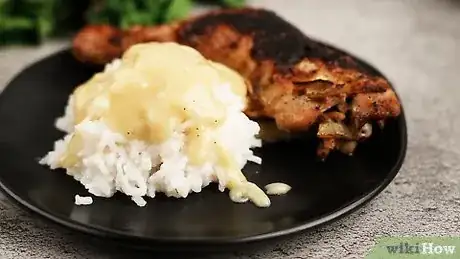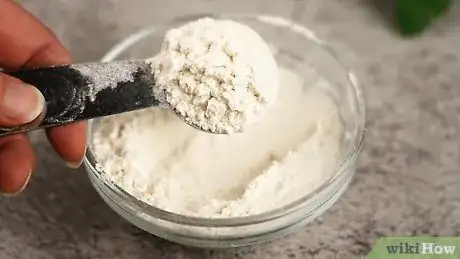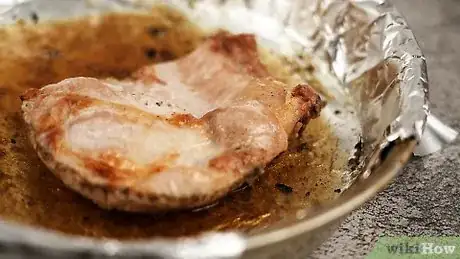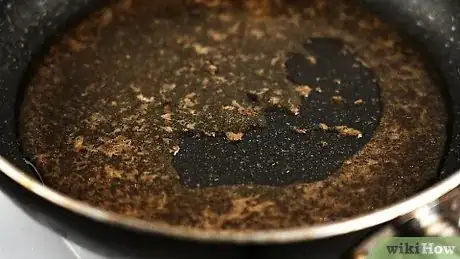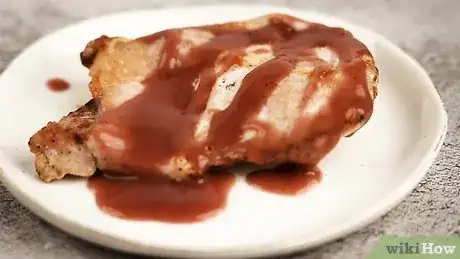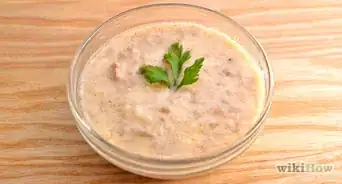This article was co-authored by Anne Lloyd. Chef Anne Lloyd is a Professional Chef and the Owner of Nolavore in New Orleans, Louisiana. Chef Anne has had a career in the restaurant and food service industries for over 30 years and has traveled and cooked on both coasts of the United States as well as in Europe and Southeast Asia. She specializes in utilizing local and regional foods to create dishes featuring international flavors. She also provides full-service catering, prepared foods, gourmet packaged goods, pantry items, and kids' cooking camps and classes for all ages. She received a BA in Anthropology from the University of California, Santa Cruz, and her Associate of Arts, Culinary Arts degree from the California Culinary Academy. Anne is an alumna of the Goldman Sachs 10,000 Small Businesses Summit.
There are 7 references cited in this article, which can be found at the bottom of the page.
wikiHow marks an article as reader-approved once it receives enough positive feedback. In this case, several readers have written to tell us that this article was helpful to them, earning it our reader-approved status.
This article has been viewed 916,520 times.
Brown gravy is not difficult to make, but the process moves quickly. All gravy starts with a simple roux, just melted flour and a fat (like butter), to provide a rich, thick base. From there you add the flavorings and coloring. Whether you're starting from scratch or whipping up gravy from the leftover juices in a roast, anyone can make brown gravy with only a few simple ingredients.
Ingredients
- 3 tablespoons butter
- 3 tablespoons flour, all-purpose/plain
- 2 cups warm liquid (stock, beef broth, water & bouillon)
- Dash salt and freshly ground black pepper
- 1/2 tsp. Kitchen Bouquet browning and seasoning sauce (optional)
- 2 tablespoons pan dripping (juices and fats left over from oven roasted meat).
- 2 tablespoons all-purpose/plain flour
- 2 cups warm liquid (stock, water, milk)
Steps
Making Basic Brown Gravy
-
1Measure out everything before beginning. If you have to leave something on the stove to measure an ingredient it could over-thicken or burn quickly. Have everything you need ready and measured ahead of time.
-
2Melt 3 tablespoons butter in a small saucepan. Melt the butter on medium heat, stirring occasionally to prevent burning. Once it is completely liquified, move on.
- You'll be mixing the flour into the butter and you do not want any chunks, as this will lead to a lumpy gravy. Whisking flour and hot butter together is the basis of a "roux."
Advertisement -
3Sprinkle in 3 tablespoons of white flour, whisking constantly. Stir continuously until the mixture becomes smooth. It is often easiest to add the flour 1 tablespoon at a time, using your whisk to quickly break up chunks and smooth out the sauce. You should notice it thickening.
- The longer you cook the flour, the darker and richer it will get. For a light gravy, move on as it turns tan. For a rich brown gravy, keep stirring and cook for an extra 3-5 minutes.
- Butter and flour give the gravy its thick, rich base. You can add more of both for a richer, thicker gravy, keeping the 2 cups of liquid the same, but keep the ratio of flour and butter equal.[1]
-
4Add your 2 cups of warmed liquid slowly and bring to a boil. Warm the liquid up in a separate pot or in the microwave before adding it. Only pour it in 1/4 cup at a time, whisking it in well before adding the next bit. You don't want to cause any rapid temperature changes in your gravy.There are a lot of options for liquids here, and it all depends on the meal you are serving. Traditionally, brown gravy has a beef base (which gives it its color), made with either beef bouillon and water or beef broth. Some other options include:
- 2 cups beef stock.
- 1 can condensed beef broth.
- You can also mix in some milk or water for a lighter gravy, but keep the ratios (2 cups total) the same.
-
5Lower the heat after boiling and let simmer until your desired thickness. As soon as the gravy starts to boil, lower the heat and let it simmer until it is as thick as you want it.
- Carefully watch and ensure that you stop cooking before the roux becomes a dark color. When the roux is darker, you're on the edge of burning it.
- The gravy will also thicken a bit as it cools, so take it off the stove 1-2 minutes before your desired consistency.
-
6Season the gravy to taste. Add a pinch of salt and pepper as it simmers, as well as any other flavorings your desire. 1/2 teaspoon of Kitchen Bouquet, a browning and seasoning mixture common in many gravies, is a great way to get "classic" gravy flavor and coloring. Other options include:
- 1/2 teaspoon garlic and/or onion powder
- 1/2 teaspoon paprika
- 1/2 teaspoon fresh thyme and rosemary
- Dash of Worcestershire sauce.[2]
-
7Serve while still warm. Either pour over meat slices directly before serving or pour into a small serving jug and place on the table for diners to serve themselves from.
Making Brown Gravy from Pan Drippings
-
1Measure out ingredients as your meat finishes roasting. The best gravy is made from pan drippings -- the juices and fats that come off the meat as it finishes roasting. This could be a beef roast, a chicken, or a turkey. When the meat has a few minutes to go, get your other ingredients out and ready to mix into your gravy:
- 2 tablespoons flour or cornstarch
- 2 cups pre-warmed liquid (chicken/beef/vegetable stock, water, milk)
- Salt and pepper to taste
-
2Remove the roast from the oven and set aside the meat. All roasts need to "stand" for 5-10 minutes before being cut up, so you have a little time to make your gravy. Tent the meat by placing foil loosely over the top and set it aside on a cutting board while you attend to the pan drippings.
-
3Strain the fat out from the liquid. Using a fine mesh sieve, separate the fat from the liquid. Save both. The fat will function just like the butter used for a basic gravy, mixing with the flour to form a roux.
- For quicker gravy, you can skip this step and simply heat up 2 tablespoons of drippings. However, the chunks of fat will lead to a lumpier, potentially less flavorful, gravy.[3]
-
4Heat the fat on the stove on medium heat. They should still be warm, but this is especially important if you've moved the drippings to another pan. However, you can also just make the gravy in your roasting pan as well. Simply put the metal pan over two burners on the stove, add the fat back in, and heat up both burners.
-
5Deglaze the pan with a splash of cool liquid and a whisk. Use a splash of red wine, water, or stock and then scrape up any brown bits of meat and juice from the bottom of the pan. As soon as you add the liquid you'll likely get a loud sizzle, and you need to work quickly with a whisk or spatula to scrape up all the stuff on the bottom of the pan.
- Deglazing is when you use a cool liquid to clean a hot pan, removing the flavorful, caramelized bits and adding them to your sauce or gravy.[4]
-
6Whisk in 2 tablespoons (29.6 ml) of flour, one at a time. Using a wire whisk, add the flour slowly with one hand while whisking with the other. You want to make a smooth, consistent sauce. Keep whisking until you've removed all the lumps.
-
7Add the 2 cups of warmed liquid slowly and whisk well. Lower the heat to medium-low and pour in your liquid 1/4 cup at a time. Whisk it in, removing lumps, then add the next 1/4 cup. Start by using the strained pan juices, then move on to other liquids if you don't have 2 cups worth. Traditionally you use stock or broth, either chicken, beef, of vegetable, but creamy gravies can use milk or heavy cream for a richer sauce. You can also combine them, using a cup of each. Whatever you use as a liquid, be sure to warm it in a separate pan or in the microwave first.
- If your gravy seems a little watery, add 1 tablespoon butter or fat and another pinch of flour and whisk well.
-
8Cook over medium-low heat for 10-15 minutes, or until desired thickness. Stir occasionally, and let the gravy simmer as it thickens. Remember, however, that all gravies will thicken as they cool, so remove it 1-2 minutes before your desired consistency.
-
9Season the gravy as it thickens. Because it is made from pan juices, the gravy will likely have a similar flavor profile as the meat that provided the base. You can add a light mixture of these same spices to help your gravy compliment the rest of the meal, or you can customize it with a variety of spices, such as:
- 1 teaspoon of green herbs, like thyme, sage, tarragon, rosemary, parsley, or chives.
- 1 teaspoon cayenne, paprika, crushed red pepper, dried mustard powder, onion and/or garlic powder.
- 1/2 teaspoon Kitchen Bouquet or Worcestershire sauce for brown coloring.
- Salt and pepper, to taste.[5]
-
10Consider straining the gravy before serving. Though not strictly necessary, you can run the gravy through a sieve before serving to remove lumps and chunks of meat. Simply pour the gravy into a sieve placed over a metal bowl, then use your wooden spoon to push it through the mesh and into the serving bowl. This leads to a restaurant quality, smoother sauce.
-
11Serve warmed. Lower the heat to low and cover if you need to prepare the rest of the meal, then serve in a dish or poured directly on top of meat. Cool gravy will thicken and congeal, and is generally unappetizing.
Expert Q&A
-
QuestionWhat is the secret to good gravy?
 Anne LloydChef Anne Lloyd is a Professional Chef and the Owner of Nolavore in New Orleans, Louisiana. Chef Anne has had a career in the restaurant and food service industries for over 30 years and has traveled and cooked on both coasts of the United States as well as in Europe and Southeast Asia. She specializes in utilizing local and regional foods to create dishes featuring international flavors. She also provides full-service catering, prepared foods, gourmet packaged goods, pantry items, and kids' cooking camps and classes for all ages. She received a BA in Anthropology from the University of California, Santa Cruz, and her Associate of Arts, Culinary Arts degree from the California Culinary Academy. Anne is an alumna of the Goldman Sachs 10,000 Small Businesses Summit.
Anne LloydChef Anne Lloyd is a Professional Chef and the Owner of Nolavore in New Orleans, Louisiana. Chef Anne has had a career in the restaurant and food service industries for over 30 years and has traveled and cooked on both coasts of the United States as well as in Europe and Southeast Asia. She specializes in utilizing local and regional foods to create dishes featuring international flavors. She also provides full-service catering, prepared foods, gourmet packaged goods, pantry items, and kids' cooking camps and classes for all ages. She received a BA in Anthropology from the University of California, Santa Cruz, and her Associate of Arts, Culinary Arts degree from the California Culinary Academy. Anne is an alumna of the Goldman Sachs 10,000 Small Businesses Summit.
Professional Chef There's a lot of things I could say about making a gravy or a roux, but the color that I'm going for is a chocolate color, so not too dark. Once it's where you want it to be, add the vegetables to slow down the cooking considerably and immediately go on to the rest of the preparation.
There's a lot of things I could say about making a gravy or a roux, but the color that I'm going for is a chocolate color, so not too dark. Once it's where you want it to be, add the vegetables to slow down the cooking considerably and immediately go on to the rest of the preparation. -
QuestionCan I sweeten gravy to go over a dessert?
 Community AnswerYes, you can! Make some gravy first, and pour it into a saucepan. Boil it for about 1 minute, stirring continuously. Next, add 4 tablespoons of sugar to it, and leave it for 2 minutes. One completed, leave it for 5 minutes to cool down, or it will be too hot.
Community AnswerYes, you can! Make some gravy first, and pour it into a saucepan. Boil it for about 1 minute, stirring continuously. Next, add 4 tablespoons of sugar to it, and leave it for 2 minutes. One completed, leave it for 5 minutes to cool down, or it will be too hot. -
QuestionCan I make gravy the night before?
 Community AnswerYou can but it could become thicker and some people like it that way, whole others do not. It's up to you if you want to make it the night before. It will still taste delicious.
Community AnswerYou can but it could become thicker and some people like it that way, whole others do not. It's up to you if you want to make it the night before. It will still taste delicious.
Things You'll Need
- Saucepan
- Wooden spoon for stirring
- Bowls
- Strainer/filter/sieve
References
- ↑ http://www.theslowroasteditalian.com/2012/07/5-minute-5-ingredient-5-star-homemade.html
- ↑ http://www.theslowroasteditalian.com/2012/07/5-minute-5-ingredient-5-star-homemade.html
- ↑ http://www.deepsouthdish.com/2009/03/easy-dark-oven-roux.html
- ↑ http://www.foodnetwork.com/recipes/gravy-from-roast-drippings-recipe.html
- ↑ http://www.food.com/recipe/basic-pan-gravy-from-drippings-426785
- Basic brown gravy adapted from Cooks.com, http://www.cooks.com/rec/view/0,1826,159180-236193,00.html
- Brown gravy from meat juices adapted from: Jill Norman, The Cook's Book, p. 219, (2005), ISBN 1-74033-454-X
- Browning any gravy adapted from: Jean Paré, Timeless Recipes for All Occasions, p. 37, (2006), ISBN 1-7415-7946-5
About This Article
To make brown gravy, start by melting 3 tablespoons of butter in a saucepan over medium heat. Then, whisk in 3 tablespoons of flour. Next, slowly add 2 cups of warmed beef broth and whisk everything together before bringing the gravy to a boil. Once it starts boiling, reduce the heat and simmer it until it's thick enough. Finally, season the gravy to taste using seasonings like onion powder, paprika, garlic powder, and fresh thyme. To learn how to make brown gravy from pan drippings, scroll down!

